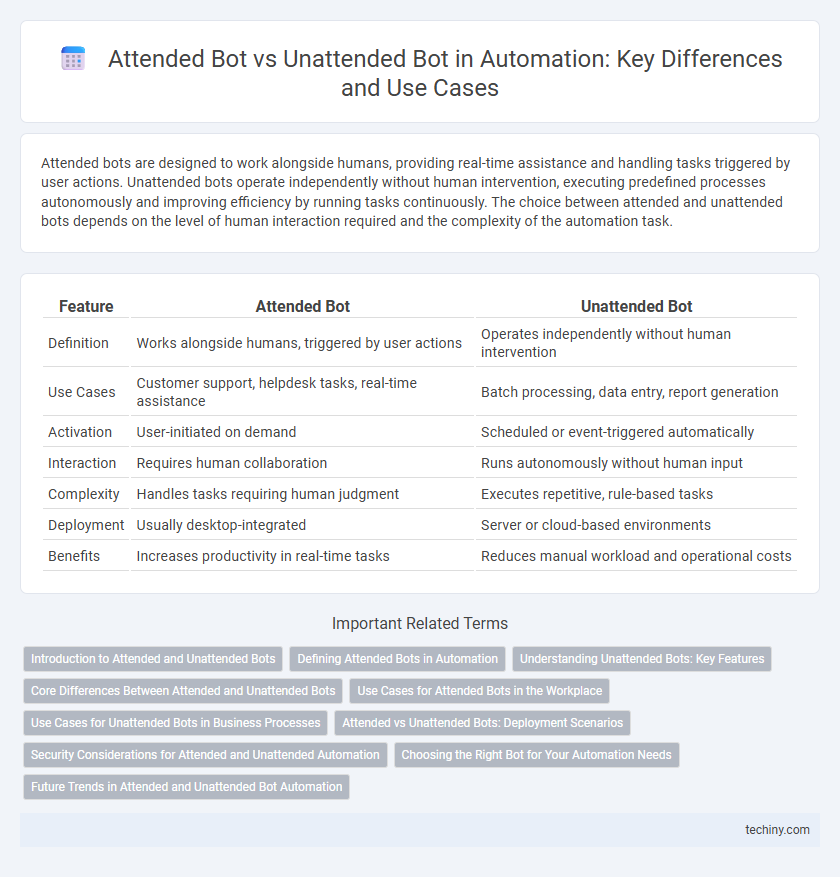Attended bots are designed to work alongside humans, providing real-time assistance and handling tasks triggered by user actions. Unattended bots operate independently without human intervention, executing predefined processes autonomously and improving efficiency by running tasks continuously. The choice between attended and unattended bots depends on the level of human interaction required and the complexity of the automation task.
Table of Comparison
| Feature | Attended Bot | Unattended Bot |
|---|---|---|
| Definition | Works alongside humans, triggered by user actions | Operates independently without human intervention |
| Use Cases | Customer support, helpdesk tasks, real-time assistance | Batch processing, data entry, report generation |
| Activation | User-initiated on demand | Scheduled or event-triggered automatically |
| Interaction | Requires human collaboration | Runs autonomously without human input |
| Complexity | Handles tasks requiring human judgment | Executes repetitive, rule-based tasks |
| Deployment | Usually desktop-integrated | Server or cloud-based environments |
| Benefits | Increases productivity in real-time tasks | Reduces manual workload and operational costs |
Introduction to Attended and Unattended Bots
Attended bots operate alongside human users, assisting with tasks that require real-time interaction and decision-making, enhancing productivity in environments like customer service and help desks. Unattended bots function independently without human intervention, executing repetitive, rule-based processes across back-office operations such as data entry and batch processing. Both types of bots leverage robotic process automation (RPA) to streamline workflows but differ in deployment and interaction levels, optimizing efficiency across front-office and back-office functions.
Defining Attended Bots in Automation
Attended bots in automation are designed to work alongside human users, assisting with tasks that require human intervention or decision-making. These bots are triggered by user actions, providing real-time support by automating repetitive or rule-based activities within attended workflows. Attended automation enhances efficiency by reducing manual effort while allowing humans to maintain control of complex processes.
Understanding Unattended Bots: Key Features
Unattended bots operate without human intervention, executing predefined, rule-based tasks across multiple systems efficiently and consistently. Key features include 24/7 operation, high accuracy in repetitive processes, and seamless integration with enterprise applications such as ERP and CRM systems. Their autonomy reduces operational costs and accelerates workflow automation, making them ideal for back-office functions like data processing and report generation.
Core Differences Between Attended and Unattended Bots
Attended bots operate alongside human users, handling tasks that require real-time interaction and immediate decision-making, while unattended bots run autonomously without human intervention for batch processing and repetitive workflows. Attended bots excel in front-office automation by assisting employees directly, whereas unattended bots dominate back-office operations through end-to-end process execution. Key distinctions include attended bots' dependency on user initiation and unattended bots' scheduling or event-triggered execution, impacting scalability and deployment complexity in robotic process automation (RPA) environments.
Use Cases for Attended Bots in the Workplace
Attended bots excel in customer service environments by assisting employees with real-time data retrieval and process automation during client interactions, significantly reducing response times. They enhance front-office operations such as helpdesk support and sales processing by seamlessly integrating with human workflows to manage repetitive tasks. These bots are ideal for scenarios requiring human intervention alongside automation, ensuring accuracy and improving overall productivity.
Use Cases for Unattended Bots in Business Processes
Unattended bots excel in automating repetitive, rule-based tasks such as data entry, invoice processing, and report generation, enabling businesses to operate 24/7 without human intervention. These bots are ideal for high-volume transactional workflows in finance, HR, and supply chain management, delivering increased accuracy and reduced operational costs. Integration with backend systems like ERP and CRM platforms ensures seamless automation of end-to-end processes, maximizing efficiency and compliance.
Attended vs Unattended Bots: Deployment Scenarios
Attended bots operate alongside human users for real-time assistance in front-office tasks, enhancing productivity by handling repetitive steps during interactive processes. Unattended bots function independently in back-office environments, executing scheduled or triggered automation without human intervention, ideal for high-volume, rule-based workflows. Deployment scenarios for attended bots typically involve customer service or helpdesk operations, while unattended bots are suited for batch processing in finance, HR, and IT services.
Security Considerations for Attended and Unattended Automation
Attended bots operate alongside human users, requiring robust endpoint security measures and strict access controls to prevent unauthorized use or data exposure during real-time interactions. Unattended bots run autonomously on servers, necessitating enhanced encryption protocols, credential vaulting, and continuous monitoring to safeguard sensitive data and ensure compliance with regulatory standards. Both automation types must implement comprehensive audit trails and role-based access to mitigate security risks effectively.
Choosing the Right Bot for Your Automation Needs
Attended bots are ideal for tasks requiring human intervention and real-time decision-making, enhancing employee productivity by handling repetitive actions triggered by user input. Unattended bots operate autonomously without human involvement, executing large volumes of rule-based processes efficiently and reducing operational costs. Selecting the right bot depends on factors such as process complexity, frequency, need for human judgment, and integration with existing workflows to maximize automation ROI.
Future Trends in Attended and Unattended Bot Automation
Future trends in attended and unattended bot automation highlight increased integration of AI-driven decision-making to enhance real-time human-bot collaboration and improve autonomous process efficiency. Enhanced contextual awareness and natural language processing will enable attended bots to provide more intuitive, adaptive support while unattended bots evolve toward fully autonomous end-to-end workflows. Enterprises are expected to adopt hybrid automation strategies leveraging cloud-based orchestration and advanced analytics to optimize scalability, reliability, and responsiveness across diverse operational environments.
attended bot vs unattended bot Infographic

 techiny.com
techiny.com